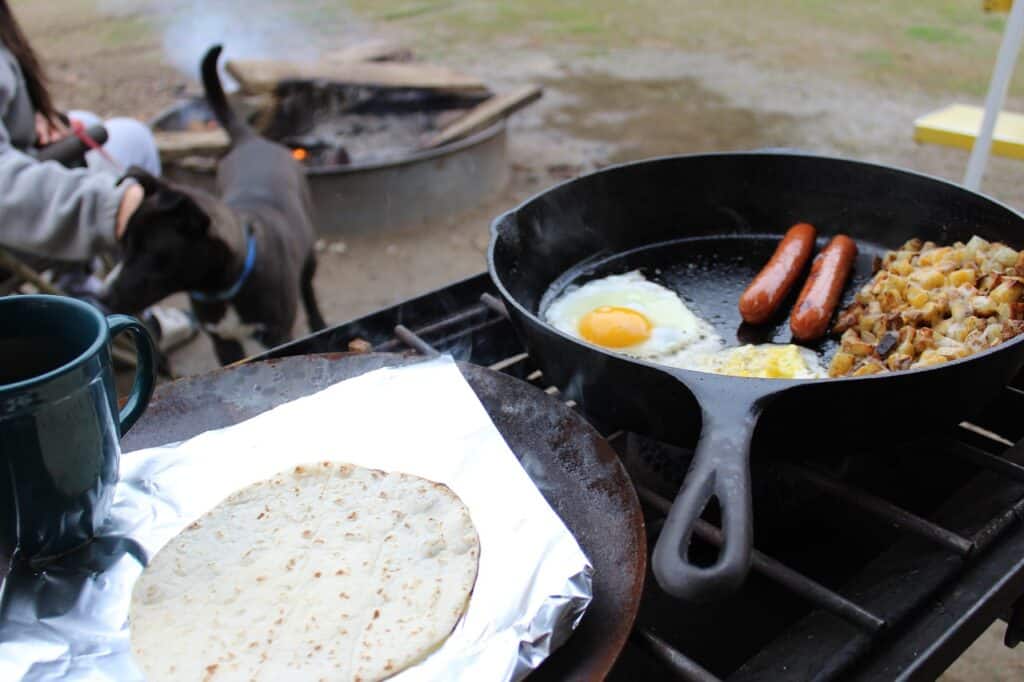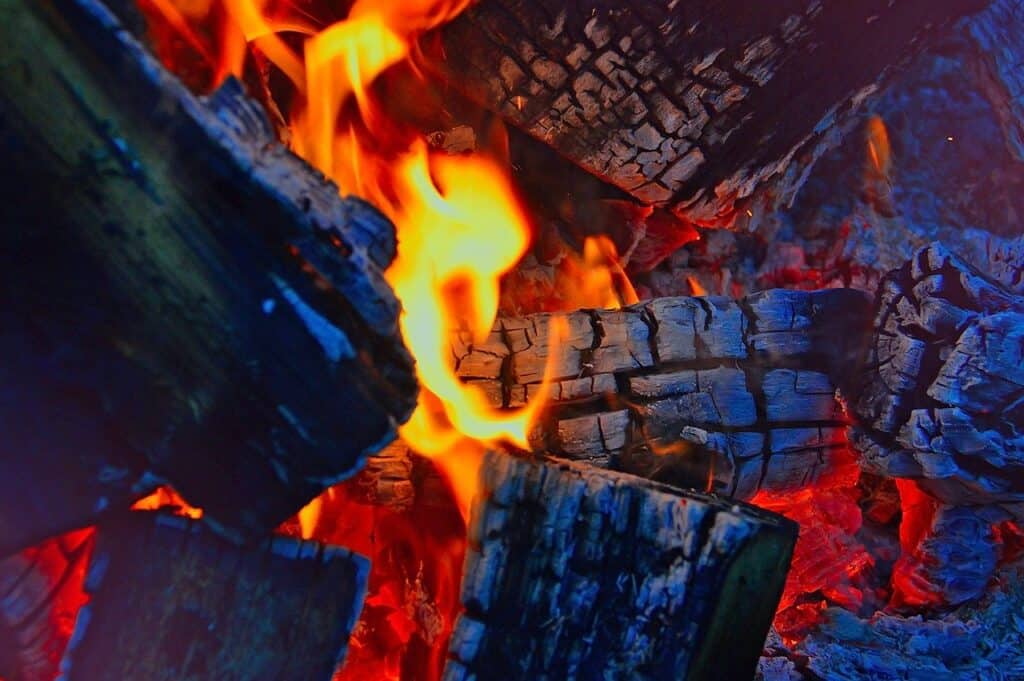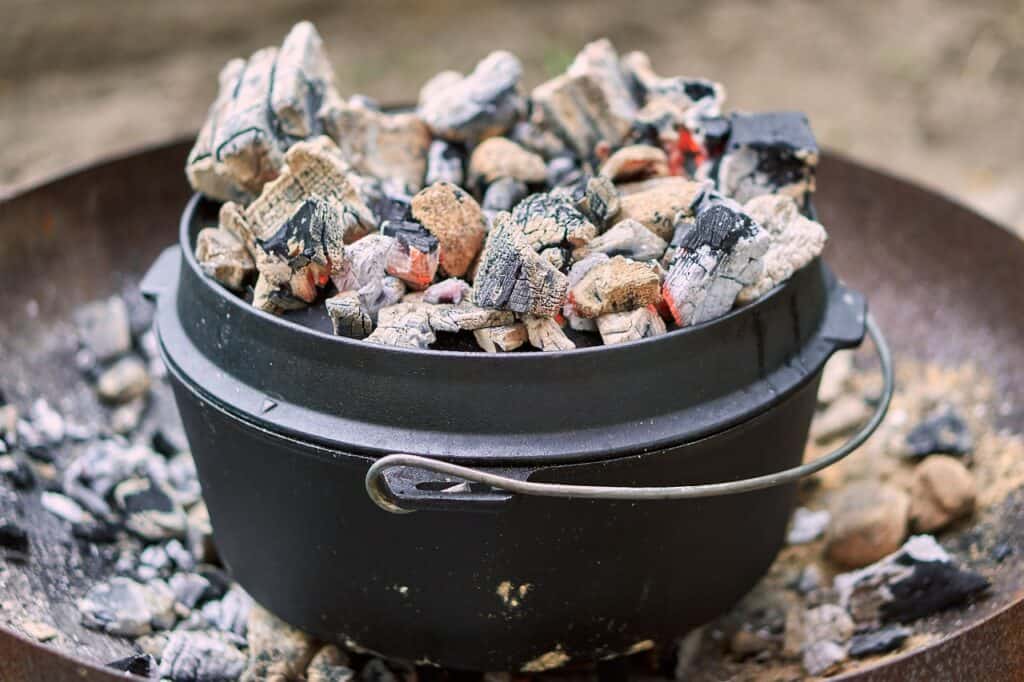I spent a lot of my youth camping in the great outdoors and cooking around a campfire, and there were a lot of lessons I learned from those many, many spring, summer, and fall weekends on camping trips whether with the family or with the Scout Troop. While not all of my great campfire cooking skills came from the early scouting days, a lot of the foundation of those skills did.
We had Scoutmasters who were very old school. They believed in eating and eating well, and were going to teach all of us every trick in the book they knew to make every meal as delicious as possible. With the exception of steak night, where the adults handled the grill get away from the fire kids, we learned how to cook everything under the sun and our meals did not compose of hot dogs and smores.
These skills have been useful throughout my life, and anywhere I go with a fire and some food I can whip up a meal that keeps me, and any nearby friends, plenty happy. And some of those skills from my Scouting days apply to cooking outside of the campfire, as well.
Let’s jump in!

Coals, Not Flames
It’s one of the first lessons you learn cooking over a campfire. Open flames are great for story-telling at night, keeping mosquitoes at bay, or creating outdoor memories. They’re also great for staring at as you slow down and get unconnected for just a little while. I like fire. I’m a huge fan. I’m in fact very much a pyro from a family of pyros…but flames aren’t great for cooking.
The point of cooking on a campfire is to really burn down the wood to get a solid bed of hot coals, and enough of them that the heat continues steadily for at least an hour. That’s what you need for steady, even cooking, and when the bed of coals are made not only do you learn the awesome lesson that food just tastes better when it’s cooked over a fire (it absolutely does) but there is a yellow-orange glow that is just hypnotically beautiful.
Plus if you prep the fire, for a pyro this is ideal. Set up a teepee fire and feed it once it falls and spreads out in the fire pit, or go with the classic log cabin setup for fire and continue to add rows on top as it burns, having it fall further into the bed of coals and adding to them.
A good bed of coals is key to a great meal over the fire.

This also gives plenty of time to prep for the meal, and double check again for spices, cooking utensils, anything else that you need. Cooking outside was something I also loved just because it was a process.
This was before the time of screens being everywhere, but even then learning to be present, to enjoy the process, to savor the rewards of that process, and the experience of delayed gratification is something that has stuck with me not only with cooking but many other things as well.
Arguably, it’s one of the most important lessons I’ve received from cooking in my Scouting days…although perfect pancakes, incredible desserts, and unbelievable meals definitely make a hard case otherwise 🙂
The Power of Cast Iron
Cast iron isn’t just for frying up large batches of breakfast food, but a cast iron Dutch Oven can do wonders not only with stew but with dessert, as well. One thing about Troop 81 out of Belle Plaine, Iowa, that no one could argue with is that we ate really, really well. In fact, we were regionally famous for that, especially after hosting a coupe of Fall Campborees.
Cast iron was a major part of everything we did, including the slow 2-hour cook for pineapple upside down cake, peach & pear cobblers, and other stunningly delicious desserts. If you’ve never cooked with a cast iron Dutch Oven over the campfire, you don’t know how amazing an experience you’ve been missing in your life. Seriously, it will be some of the best meals you will ever have and often in a setting that lets you truly enjoy it.

Many of my favorite memories from campouts involve prepping the fire, the food, and then setting Dutch ovens filled with dessert into the coals before shoveling coals on the lid to help even out the heat throughout the Dutch Oven and ensure more even cooking.
When it came to camping, van life, long-term camping, it showed the value of Dutch Ovens in cooking delicious meals, but since these are very heavy if you travel via backpacking…well it just isn’t possible, period.
But the versatility of what Dutch Ovens can cook is something that stuck with me. Finding versatile pieces of equipment, in whatever you’re doing is good advice but with cooking it is especially powerful.
Just a few of the many delicious dishes I’ve made with a Dutch Oven include:
- Stew
- Peach cobbler
- Pear cobbler
- Apple pie
- Pineapple upside down cake
- Breakfast casserole
- Tator tot casserole
- Spaghetti
- Pot roast
- Chili
- Cheese, potato, & ham soup
There were many other recipes I wanted to try, but they will have to wait for the next campout. The point is, the sheer versatility of the dishes there is pretty amazing and shows just how many options an experienced cook has when it comes to cooking with Dutch Ovens, or any really good piece of cookware.
This was also the start of my love for cast iron and the understanding that good, truly good, cooking utensils matter. You can cheap out if you have no choice, but the quality will suffer so purchase and prepare accordingly.
Don’t Underestimate the Power of Even Moderate Spices
Most people don’t bring a lot of spices with them, and I’ve never understood that. I have one fanny pack, and it’s literally just used to put in small bottles of spices in once place so they don’t accidentally open in my travel bag and then give me garlic-smelling underwear.
Granted, I go a bit overboard because I love my seasonings. And if there are local herbs I can find and forage in the wild, confident they are pesticide free or at least relatively safe I’m happy to add them, but I don’t do extensive traveling, especially outdoor related, without my spices.
A little bit goes a long way and a pinch of salt, a pinch of pepper, Lawry’s seasoning salt for the potato wedges, and some garlic salt goes a long way no matter what you’re cooking. If you want an out of this world spaghetti sauce, on the other hand, you need to learn how to use thyme, oregano, and basil, but as long as you are starting out with the basics and not trying to go next level on the spaghetti sauce on the campfire a little bit of spice goes a long way.
The short list for starters:
- Black pepper
- Garlic powder
- Salt (just don’t go overboard like almost everyone does)
- Lawry’s seasoning salt for potato fries
- Cinnamon for desserts (cakes, cobblers)
These spices are enough to go a long way and flavor up a lot of dishes in really good ways when campfire cooking. Don’t underestimate what seasoning the meat with salt and pepper before tossing it into the beef stroganoff will do to add flavor to the entire dish.
Cinnamon is great for dessert, and a small amount adds that extra little something to Chicken Fettucine. Yeah, I know, that sounds weird, but it’s a very common trick of chefs who are much better than you and I, so trust the professionals – it works. Just don’t overdo it!
Slow and Steady Vs Fast
Slow heat is your friend, and it’s the friend of good tasting food. Look, there’s a place for microwave dinners and there’s a reason they became so popular. They’re fast, they are low effort, but there isn’t a microwave dinner in existence that competes with a good home cooked meal.
This is the same reason most recipes are low to medium heat, and while I always recommend using the low heat on a crock pot. Low heat cooking and low-medium heat cooking takes a lot longer, but the food is better. Veggies are thoroughly cooked, meat melts off the fork, and it’s really, really hard to ruin a dish when you take the extra time to cook it thoroughly on low heat.
Slow and steady not only wins the race when it comes to better cooking, but also gives time to talk to good friends, read a book, get some exercise in, or otherwise make the most of the wonderful world and limited time we all have in this life.
Everything Tastes Better Cooked on Fire
Hey the old idiom is true. Things just taste better off the campfire. Whether it’s being out in the wild, disconnected from stress, the taste imbued from smoke and old fashioned cooking techniques, the effort put in, or all of the above, there’s just something about meals that came off a campfire that taste better.
Almost every outdoor enthusiast I know have stories about an amazing lunch after hiking 10 miles, or the best spaghetti ever after a long rainy day camping, or some other meal. Everyone has a “that great meal” story from outside around a fire, and it doesn’t matter to me if there’s ever a scientific study on this or not, but it’s one of those universal truths that I’m going to choose to believe.
Food tastes better off the fire. Period.
Camping Is No Excuse for Weak Food
Look, I have nothing against hot dogs, smores, and even the occasional burger. These are great camping foods and there’s a reason they’re classics. Easy to grill, easy to cook over an open fire, and good luck finding a better hot dog than one cooked right over the open flames via hot dog fork (the one time cooking with flames is acceptable), this shouldn’t be the only food for any campout.
These should just be supplemental snacks. You not only can have good meals while camping but you can have delicious amazing meals while out cooking over camp fires. This has been proven many times before, and frankly I find camping a great time to not only have some of the best meals of your life but to also be in a situation where you will appreciate them the most.
This is also a great time to show off those skills, and who doesn’t enjoy a “chore” that also has you starting, tending, and enjoying time by the fire?
A Good Meal Sets the Tone
A good meal not only sets the tone for the setting, but it’s a great experience and mood lifter in and of itself. I can’t count the number of times a great day was topped off by a great meal and led to stories, conversations, stories, or just great conversations long into the night around a fire ring.
A good meal whether around the campfire, at an apartment gathering of friends, or even at a public outing – the food sets the tone. A great meal that is filling and delicious just sets a good mood and a good tone for the whole day.
This is a fantastic lesson to learn, not to mention experience. If you have the ability to pick up a skill that lets you set the tone as a good one for future get-togethers, why wouldn’t you do that? Why wouldn’t you want to show that off?
A good meal really sets the tone for a day and so becoming a better cook not only served myself in many times in life, but it also helped create a better meal and experience for others. Being a part of making positive memories is a really cool thing – and to do it with a skill that will always pay-off for you in other ways, that’s just a win-win all the way around.
In Conclusion
While I don’t manage to get out to the cooking fires as much as I used to or would love to given the perfect situation, these cooking skills have stayed with me back to the kitchen, out on the grill on the deck, or anywhere else I get to stretch those cooking skills. That cooking merit badge from my scouting days was well-earned, and as far as I know no scout ever came close to dethroning my well-known skills for making the best pancakes ever over the campfire.
Something that I always found funny since I didn’t really like pancakes back then. But even then, I appreciated figuring out the intricacies, the little details you could focus on that would allow you to cook a better meal. This was a skill I could visibly see people appreciate, and having had an incredibly rough elementary school, middle school, and high school experience, so finding a skill that won me positive words from adults, from classmates, from the friend or two I actually made, that was a sure sign it was a skill I would pursue early and often.
The outdoor life is a rewarding experience, and whether helping a friend setup a long-term homestead, backpacking during a thru hike, or just finding a nice out of the way spot for a multi-week campout, having the ability to make stunningly delicious food has always been a blessing and is one of the lessons from my time earning my Eagle Scout that I cherish most.
Other Articles You May Enjoy:
